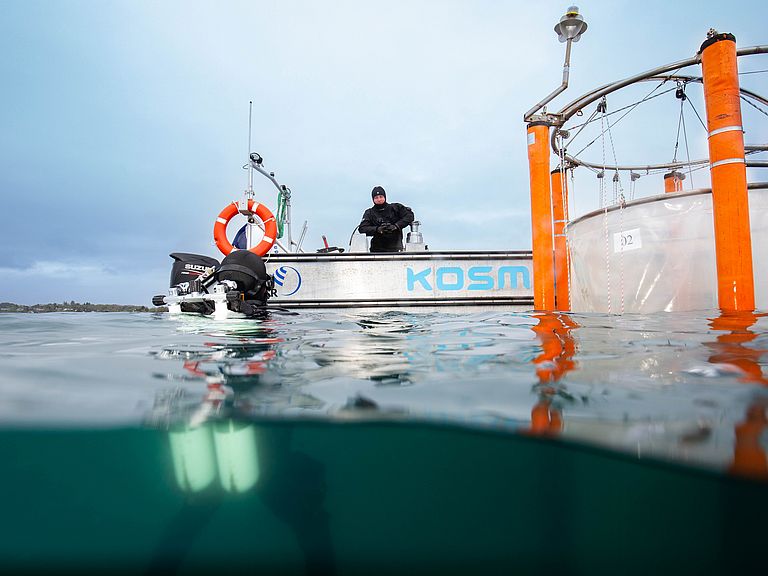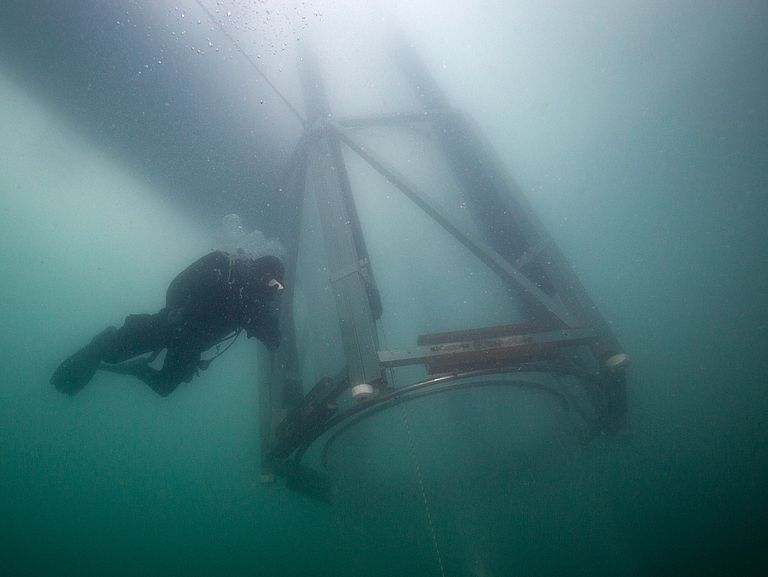Using alkaline rock minerals to combat climate change
The OceanNETs project explores an approach for carbon dioxide removal in a Norwegian fjord
The target is clear: In the Paris Agreement, the global community agreed to limit global warming to well below 2° Celsius and to make efforts to keep it below 1.5° Celsius. This can only be achieved if we drastically reduce our greenhouse gas emissions and take measures to actively remove carbon dioxide (CO2) from the atmosphere again – in other words, create “negative emissions”. To what extent the ocean can support this and what risks and side effects might occur is currently being investigated by an international 43-member research team led by GEOMAR Helmholtz Centre for Ocean Research Kiel in a study south of Bergen, Norway.
For the long-term experiment, the researchers are using mesocosms developed at GEOMAR, which are a type of oversized test tube, 20 metres long and two metres in diameter. In the sealed containers, the pH value of the seawater is raised by the addition of alkaline minerals. This so-called alkalinization not only counteracts ocean acidification, it also enhances the ocean's potential to take up and store CO2. Regular sampling and measurements document the chemical and biological changes in the mesocosms over a period of about eight weeks.
The investigated approach simulates a natural process: In nature, minerals from rocks and soils are partially responsible for maintaining the alkalinity of seawater. In the experiment, slaked lime - representing calcium-based minerals - and magnesium silicate - representing siliceous minerals - are used for alkalinization, because they dissolve easily in water and are free of impurities often contained in minerals. The experiment aims to clarify how effectively this sequesters additional CO2, which of the two substances produces better results and, most importantly, how ocean alkalinization affects marine life.
“We need to work on ways to actively mitigate climate change. The problem is becoming more and more pressing. Even if we manage to reduce CO2 emissions fast and radically, there will still remain CO2 emission we cannot avoid,” says Professor Dr. Ulf Riebesell, marine biologist at GEOMAR and project leader of the study. “With our research, we want to help develop safe and sustainable solutions which can remove carbon dioxide from the atmosphere. In doing so, it is important to ensure that negative impacts on the marine environment are prevented.”
Mesocosm studies are particularly suitable for investigating the effects of changes in seawater chemistry without affecting the marine environment. The sealed structure of the “giant test tubes” allows conditions in the enclosed water to be altered in a controlled manner. Mesocosms contain natural communities and are exposed to real environmental conditions during experiments, so that close-to-natural conditions can be simulated. This is not possible in the laboratory.
In addition to the scientists from GEOMAR, researchers from the University of Bergen, Kiel University, University of Hamburg, the University of Las Palmas Gran Canaria, the Alfred Wegener Institute, Helmholtz Centre for Polar and Marine Research, the Bigelow Laboratory for Ocean Sciences, the University of Tasmania, Southern Cross University, the University of Agder and the Technical University of Denmark are involved in the experiment.
“The results of the study in Norway and of a similar experiment conducted in Gran Canaria in the fall of 2021 will feed into an overarching assessment of different ocean-based measures for active CO2 removal,” explains Dr. David Keller, Earth system modeler at GEOMAR and coordinator of OceanNETs. “Within our project, we take a transdisciplinary approach which, in addition to natural sciences, takes economic, legal, and social aspects into consideration. Our results and assessments should help provide a basis for decision-making on the potential use of active CO2 removal measures. Which measures are ultimately used can only be decided by weighing up all the risks and benefits, and by integrating this knowledge into climate change mitigation decisions involving society as a whole.”
Project funding and coordination:
In addition to the OceanNETs project, which is funded by the European Union under the Horizon2020 program, the Bergen study is co-funded by the EU project AQUACOSM-plus. The OceanNETs project is coordinated at GEOMAR by Dr. David Keller.

![[Translate to English:] Research vessel ALKOR](/fileadmin/_processed_/1/a/csm_20220507_Deployment-Mesocosms-Bergen_UlfRiebesell-GEOMAR_a550555273.jpg)


![[Translate to English:] Mesokosmen](/fileadmin/_processed_/2/e/csm_20220516_Mesocosms-Bergen_UlfRiebesell-GEOMAR_fb53dbd991.jpg)


